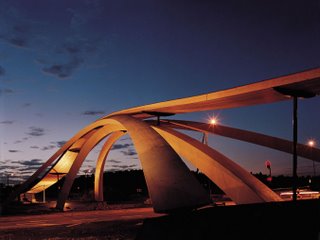 The first Leonardo Bridge in the town of As, near Oslo in Norway. Photo by Terje Johansen. This article was originally published in my Tree News magazine [Autumn/Winter 2005]
The first Leonardo Bridge in the town of As, near Oslo in Norway. Photo by Terje Johansen. This article was originally published in my Tree News magazine [Autumn/Winter 2005]A visionary project aimed at building a global network of landmark wooden bridges on every continent, based on an original design by Leonardo da Vinci, is the brainchild of Norwegian artist Vebjørn Sand.
According to his mission statement: This global public art and civil engineering project, honouring the legacy of curiosity about the natural world left to us by Leonardo, integrates the disciplines of art, architecture, natural sciences, history, civil engineering and mathematics, linking people around the world.'
Leonardo wrote a letter in 1502 to Sultan Bejazet II in which he outlined his plan to bridge the
Sand was thirty when he first saw Leonardo's drawing for the bridge in a show of the master's inventions held in